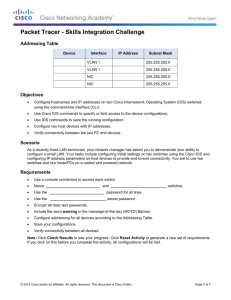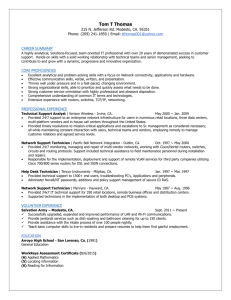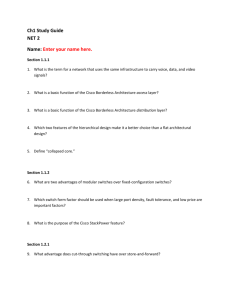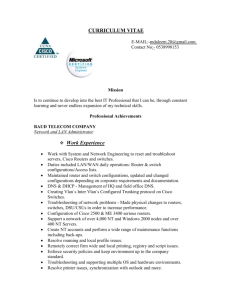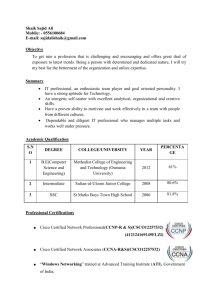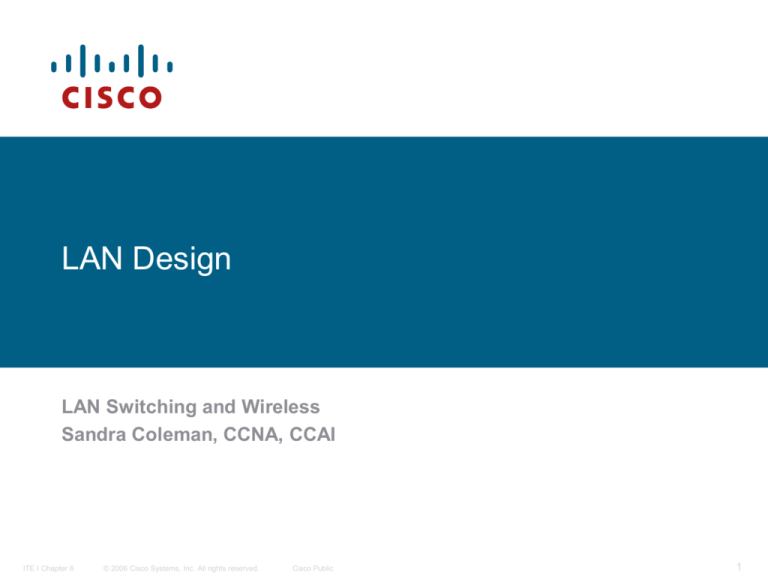
LAN Design
LAN Switching and Wireless
Sandra Coleman, CCNA, CCAI
ITE I Chapter 6
© 2006 Cisco Systems, Inc. All rights reserved.
Cisco Public
1
Objectives
Describe how a hierarchical network supports the
voice, video and data needs of a small and mediumsized business.
Match the appropriate Cisco switch to each layer in
the hierarchical network design model.
ITE 1 Chapter 6
© 2006 Cisco Systems, Inc. All rights reserved.
Cisco Public
2
Hierarchical Network Model
When building a LAN that satisfies the needs of a small- or medium-sized
business, your plan is more likely to be successful if a hierarchical design
model is used.
–Hierarchical network design involves dividing the network into discrete layers.
–Each layer provides specific functions that define its role within the overall network.
–By separating the various functions that exist on a network, the network design
becomes modular, which facilitates scalability and performance.
The typical hierarchical design model is broken up in to three layers:
–access
–distribution
–core
ITE 1 Chapter 6
© 2006 Cisco Systems, Inc. All rights reserved.
Cisco Public
3
Hierarchical Network Model – Access Layer
• The access layer interfaces with end devices, such as PCs,
printers, and IP phones, to provide access to the rest of the
network.
• The access layer can include routers, switches, bridges, hubs,
and wireless access points.
• The main purpose of the access layer is to provide a means of
connecting devices to the network and controlling which devices
are allowed to communicate on the network.
ITE 1 Chapter 6
© 2006 Cisco Systems, Inc. All rights reserved.
Cisco Public
4
Hierarchical Network Model – Distribution Layer
• The distribution layer gathers the data received from the access layer switches
before it is transmitted to the core layer for routing to its final destination.
• The distribution layer controls the flow of network traffic using policies and
delineates broadcast domains by performing routing functions between virtual
LANs (VLANs) defined at the access layer.
• VLANs allow you to segment the traffic on a switch into separate subnetworks.
– For example, in a university you might separate traffic according to faculty, students, and guests.
• Distribution layer switches are typically high-performance devices that have
high availability and redundancy to ensure reliability.
ITE 1 Chapter 6
© 2006 Cisco Systems, Inc. All rights reserved.
Cisco Public
5
Hierarchical Network Model – Core Layer
• The core layer of the hierarchical design is the high-speed backbone of the
internetwork.
• The core layer is critical for interconnectivity between distribution layer devices,
so it is important for the core to be highly available and redundant.
• The core area can also connect to Internet resources.
• The core aggregates the traffic from all the distribution layer devices, so it must
be capable of forwarding large amounts of data quickly.
In smaller networks, it is not unusual to implement a collapsed core model, where
the distribution layer and core layer are combined into one layer.
ITE 1 Chapter 6
© 2006 Cisco Systems, Inc. All rights reserved.
Cisco Public
6
Hierarchical Network Model
Logical Layout
–The access, distribution, and core layers
are separated into a well-defined hierarchy.
–This logical representation makes it easy to
see which switches perform which function.
–It is much harder to see these hierarchical
layers when the network is installed in a
business.
Physical Layout
–The figure shows two floors of a building.
•The user computers and network devices that
need network access are on one floor.
•The resources, such as e-mail servers and
database servers, are located on another floor.
–To ensure that each floor has access to the
network, access layer and distribution
switches are installed in the wiring closets of
each floor and connected to each of the
devices needing network access.
–The access layer switch and distribution
layer switch are stacked one on top of each
other in the wiring closet.
ITE 1 Chapter 6
© 2006 Cisco Systems, Inc. All rights reserved.
Cisco Public
7
Benefits of Hierarchical Model –
Know these!
ITE 1 Chapter 6
© 2006 Cisco Systems, Inc. All rights reserved.
Cisco Public
8
Benefits of a Hierarchical Network
Scalability
–The modularity of the design allows you to replicate design elements as the network
grows.
–Because each instance of the module is consistent, expansion is easy to plan and
implement.
–For example, if your design model consists of two distribution layer switches for
every 10 access layer switches, you can continue to add access layer switches until
you have 10 access layer switches cross-connected to the two distribution layer
switches before you need to add additional distribution layer switches to the network
topology.
Redundancy
–You can dramatically increase availability through easy redundant implementations
with hierarchical networks.
–Access layer switches are connected to two different distribution layer switches to
ensure path redundancy.
•If one of the distribution layer switches fails, the access layer switch can switch to the other
distribution layer switch.
–Additionally, distribution layer switches are connected to two or more core layer
switches to ensure path availability if a core switch fails.
–The only layer where redundancy is limited is at the access layer.
•Typically, end node devices, such as PCs, printers, and IP phones, do not have the ability to
connect to multiple access layer switches for redundancy.
•If an access layer switch fails, just the devices connected to that one switch would be
affected by the outage. The rest of the network would continue to function unaffected..
ITE 1 Chapter 6
© 2006 Cisco Systems, Inc. All rights reserved.
Cisco Public
9
Benefits of a Hierarchical Network
Performance
–Data is sent through aggregated switch port links from the access layer to
the distribution layer at near wire speed in most cases.
–The distribution layer then uses its high performance switching capabilities
to forward the traffic up to the core, where it is routed to its final destination.
–As a result, properly designed hierarchical networks can achieve near wire
speed between all devices..
Security
–Access layer switches can be configured with various port security options
that provide control over which devices are allowed to connect to the
network.
–You have the flexibility to use more advanced security policies at the
distribution layer.
•You may apply access control policies that define which communication
protocols are deployed on your network and where they are permitted to go.
–For example, if you want to limit the use of HTTP to a specific user
community connected at the access layer, you could apply a policy that
blocks HTTP traffic at the distribution layer.
–Some access layer switches support Layer 3 functionality, but it is usually
the job of the distribution layer switches to process Layer 3 data, because
they can process it much more efficiently.
ITE 1 Chapter 6
© 2006 Cisco Systems, Inc. All rights reserved.
Cisco Public
10
Benefits of a Hierarchical Network
Manageability
–Each layer of the hierarchical design performs specific functions that are
consistent throughout that layer.
•Therefore, if you need to change the functionality of an access layer switch, you
could repeat that change across all access layer switches in the network because
they presumably perform the same functions at their layer.
–Deployment of new switches is also simplified because switch
configurations can be copied between devices with very few modifications.
–Consistency between the switches at each layer allows for rapid recovery
and simplified troubleshooting.
Maintainability
–In some network design models, there is a finite limit to how large the
network can grow before it becomes too complicated and expensive to
maintain.
•In the hierarchical design model, switch functions are defined at each layer,
making the selection of the correct switch easier.
–For a full mesh network topology to achieve maximum performance, all
switches need to be high-performance switches, because each switch needs
to be capable of performing all the functions on the network.
ITE 1 Chapter 6
© 2006 Cisco Systems, Inc. All rights reserved.
Cisco Public
11
Principles of Hierarchical Network Design
–Network Diameter
• Diameter is usually a measure of distance, but in this case, we are
using the term to measure the number of devices. Network diameter is
the number of devices that a packet has to cross before it reaches its
destination.
–Bandwidth Aggregation
• Bandwidth aggregation is the practice of considering the specific
bandwidth requirements of each part of the hierarchy.
• After bandwidth requirements of the network are known, links between
specific switches can be aggregated, which is called link aggregation.
• Link aggregation allows multiple switch port links to be combined so
as to achieve higher throughput between switches.
–Redundancy
• Redundancy is one part of creating a highly available network.
ITE 1 Chapter 6
© 2006 Cisco Systems, Inc. All rights reserved.
Cisco Public
12
Principles of Hierarchical Network Design
Network Diameter
–When designing a hierarchical network
topology, the first thing to consider is network
diameter.
–Network diameter is the number of devices that
a packet has to cross before it reaches its
destination.
–In the figure, PC1 communicates with PC3.
There could be up to six interconnected switches
between PC1 and PC3. In this case, the network
diameter is 6.
–In the three-layer hierarchical model, Layer 2
segmentation at the distribution layer practically
eliminates network diameter as an issue.
•In a hierarchical network, network diameter is
always going to be a predictable number of hops
between the source and destination devices.
What this means is that when the frame hits
the layer 3 device, the diameter is reset back to
0.
ITE 1 Chapter 6
© 2006 Cisco Systems, Inc. All rights reserved.
Cisco Public
13
Principles of Hierarchical Network Design
Bandwidth Aggregation
–Link aggregation allows multiple switch port links to
be combined so as to achieve higher throughput
between switches.
–Cisco has a proprietary link aggregation
technology called EtherChannel, which allows
multiple Ethernet links to be consolidated.
•CCNP.
–In figure, computers PC1 and PC3 require a
significant amount of bandwidth because they are
used for developing weather simulations.
•The network manager has determined that the access
layer switches S1, S3, and S5 require increased
bandwidth.
•Following up the hierarchy, these access layer
switches connect to the distribution switches D1, D2,
and D4. The distribution switches connect to core layer
switches C1 and C2.
–Notice how specific links on specific ports in each switch
are aggregated. In this way, increased bandwidth is
provided for in a targeted, specific part of the network.
What they are trying to say here is that combining multiple
physical links to create a logical link to provide more bandwidth.
EtherChannel is a technology allows you to combine multiple
physical links into one logical link.
ITE 1 Chapter 6
© 2006 Cisco Systems, Inc. All rights reserved.
Cisco Public
14
Principles of Hierarchical Network Design
Redundancy – helps prevent route failure
–Redundancy is one part of creating a highly available
network.
–Redundancy can be provided in a number of ways.
•For example, you can double up the network connections
between devices, or you can double the devices
themselves.
–Implementing redundant links can be expensive.
•Imagine if every switch had a connection to every switch
at the next layer.
•It is unlikely that you will be able to implement
redundancy at the access layer because of the cost and
limited features in the end devices.
–In the figure, redundant links are shown at the
distribution layer and core layer. At the distribution
layer, there are two distribution layer switches, the
minimum required to support redundancy at this layer.
•The access layer switches, S1, S3, S4, and S6, are
cross-connected to the distribution layer switches. This
protects your network if one of the distribution switches
fails.
Some network failure scenarios can never be prevented, for example, if the
power goes out in the entire city, or the entire building is demolished because of
an earthquake. Redundancy does not attempt to address these types of
disasters.
ITE 1 Chapter 6
© 2006 Cisco Systems, Inc. All rights reserved.
Cisco Public
15
What is a Converged Network?
Small and medium-sized businesses are embracing the
idea of running voice and video services on their data
networks.
–Convergence is the process of combining voice and video
communications on a data network.
Legacy Equipment
–Converged networks have existed for a while now, but were
only feasible in large enterprise organizations
–Most telephone companies today have made the transition to
digital-based switches. However, there are many offices that
still use analog phones, so they still have existing analog
telephone wiring closets.
Advanced Technology
–Converging voice, video, and data networks has become
more popular recently in the small to medium-sized business
market because of advancements in technology.
–Moving to a converged network can be a difficult decision if
the business already invested in separate voice, video, and
data networks.
–One benefit of a converged network is that there is just one
network to manage.
–a high-end VoIP phone and switch combination suitable for a
medium-sized business of 250-400 employees
ITE 1 Chapter 6
© 2006 Cisco Systems, Inc. All rights reserved.
Cisco Public
16
What is a Converged Network?
New Options
You can now tie voice and video
communications directly into an employee's
personal computer system.
–There is no need for an expensive handset
phone or videoconferencing equipment.
•You can accomplish the same function using
special software integrated with a personal
computer.
–Softphones, such as the Cisco IP
Communicator, offer a lot of flexibility for
businesses.
•When software is used in place of a physical
phone, a business can quickly convert to
converged networks, because there is no capital
expense in purchasing IP phones and the
switches needed to power the phones.
–With the addition of inexpensive webcams,
videoconferencing can be added to a softphone.
ITE 1 Chapter 6
© 2006 Cisco Systems, Inc. All rights reserved.
Cisco Public
17
What is a Converged Network?
Separate Voice, Video and Data Networks
–Voice network
•A voice network contains isolated phone lines running to a PBX
switch to allow phone connectivity to the PSTN.
•When a new phone is added, a new line has to be run back to
the PBX. The PBX switch is typically located in a Telco wiring
closet, separate from the data and video wiring closets.
•However, using a properly designed hierarchical network, and
implementing QoS policies that prioritize the audio data, voice
data can be converged onto an existing data network with little to
no impact on audio quality.
–Video network
•Videoconferencing data can consume significant bandwidth on
a network. As a result, video networks were maintained
separately to allow the videoconferencing equipment to operate
at full speed without competing for bandwidth with voice and
data streams.
•Using a properly designed hierarchical network, and
implementing QoS policies that prioritize the video data, video
can be converged onto an existing data network with little to no
impact on video quality.
–Data network
•The data network interconnects the workstations and servers
on a network to facilitate resource sharing.
•Now that properly designed hierarchical networks can
accommodate the bandwidth requirements of voice, video, and
data communications at the same time, it makes sense to
converge them all onto a single hierarchical network.
ITE 1 Chapter 6
© 2006 Cisco Systems, Inc. All rights reserved.
Cisco Public
18
Considerations for Hierarchical Network Switches
Traffic Flow Analysis
–Traffic flow analysis is the process of measuring the bandwidth usage on a
network and analyzing the data for the purpose of performance tuning,
capacity planning, and making hardware improvement decisions.
–When choosing new switches or replacing old ones, always consider
the traffic flow, and expected future growth.
Analysis Tools
–Many traffic flow analysis tools that automatically record traffic flow data to
a database and perform a trend analysis are available.
–The figure displays sample output from Solarwinds Orion 8.1 NetFlow
Analysis, which monitors traffic flow on a network.
ITE 1 Chapter 6
© 2006 Cisco Systems, Inc. All rights reserved.
Cisco Public
19
Considerations for Hierarchical Network Switches
User Communities Analysis
–User community analysis is the process
of identifying various groupings of users
and their impact on network performance.
•In a typical office building, end users are
grouped according to their job function,
because they require similar access to
resources and applications.
•As shown in the figure, the HR department
requires 20 workstations for its 20 users.
That translates to 20 switch ports needed to
connect the workstations to the network.
•If you were to select an appropriate access
layer switch to accommodate the HR
department, you would probably choose a
24 port switch, which has enough ports to
accommodate the 20 workstations and the
uplinks to the distribution layer switches.
ITE 1 Chapter 6
© 2006 Cisco Systems, Inc. All rights reserved.
Cisco Public
20
Considerations for Hierarchical Network Switches
User Communities Analysis
–The location of the user communities
influences where data stores and server
farms are located.
•If the Finance users are using a networkintensive application that exchanges data
with a specific server on the network, it may
make sense to locate the Finance user
community close to that server.
•By locating users close to their servers and
data stores, you can reduce the network
diameter for their communications, thereby
reducing the impact of their traffic across
the rest of the network.
•One complication of analyzing application
usage by user communities is that usage is
not always bound by department or
physical location. You may have to analyze
the impact of the application across many
network switches to determine its overall
impact.
ITE 1 Chapter 6
© 2006 Cisco Systems, Inc. All rights reserved.
Cisco Public
21
Considerations for Hierarchical Network Switches
Future Growth
– A solid network plan includes the rate of personnel growth
over the past five years to be able to anticipate the future
growth.
• Additionally, a good network design plan factors in the growth of each
department to ensure that there are enough open switch ports that
can utilized before the next planned upgrade to the network.
ITE 1 Chapter 6
© 2006 Cisco Systems, Inc. All rights reserved.
Cisco Public
22
Considerations for Hierarchical Network Switches
Data Stores and Data Servers Analysis
–When analyzing traffic on a network, consider where
the data stores and servers are located so that you can
determine the impact of traffic on the network.
•Data stores can be servers, storage area networks
(SANs), network-attached storage (NAS), tape backup
units, or any other device or component where large
quantities of data are stored.
–When considering the traffic for data stores and
servers, consider both client-server traffic and serverserver traffic.
•Client-server traffic is the traffic generated when a client
device accesses data from data stores or servers.
–Client-server traffic typically traverses multiple switches to
reach its destination.
–Bandwidth aggregation and switch forwarding rates are
important factors to consider when attempting to eliminate
bottlenecks for this type of traffic.
•Server-server traffic is the traffic generated between data
storage devices on the network.
–Some server applications generate very high volumes of
traffic between data stores and other servers.
–To optimize server-server traffic, servers needing frequent
access to certain resources should be located in close
proximity to each other so that the traffic they generate does
not affect the performance of the rest of the network.
ITE 1 Chapter 6
© 2006 Cisco Systems, Inc. All rights reserved.
Cisco Public
23
Considerations for Hierarchical Network Switches
Topology Diagrams
–A topology diagram is a graphical
representation of a network infrastructure.
•A topology diagram shows how all switches
are interconnected, detailed down to which
switch port interconnects the devices.
•A topology diagram graphically displays any
redundant paths or aggregated ports between
switches that provide for resiliency and
performance.
–A network topology can be very difficult to
piece together after the fact if you were not
part of the design process.
•Network cables in the wiring closets
disappear into the floors and ceilings, making
it difficult to trace their destinations.
•And because devices are spread throughout
the building, it is difficult to know how all of the
pieces are connected together.
•With patience, you can determine just how
everything is interconnected and then
document the network infrastructure in a
topology diagram.
ITE 1 Chapter 6
© 2006 Cisco Systems, Inc. All rights reserved.
Cisco Public
24
Switch Features
Switch Form Factors
–When you are selecting a switch, you need to
decide between
•Fixed configuration
•Modular configuration
•Stackable
•Non-stackable.
–Another consideration is the thickness of the
switch expressed in number of rack units.
•For example, the Fixed Configuration
Switches shown in the figure are all 1U.
ITE 1 Chapter 6
© 2006 Cisco Systems, Inc. All rights reserved.
Cisco Public
25
Switch Features
Fixed Configuration Switches
–Fixed configuration switches means is that you cannot
add features or options to the switch beyond those that
originally came with the switch.
–For example, if you purchase a 24-port gigabit fixed
switch, you cannot add additional ports when you need
them.
–There are typically different configuration choices that
vary in how many and what types of ports are included.
Modular Switches –FLEXIBLE!!
–Modular switches typically come with different sized
chassis that allow for the installation of different
numbers of modular line cards.
–The line cards actually contain the ports.
–The line card fits into the switch chassis like expansion
cards fit into a PC. The larger the chassis, the more
modules it can support.
–As you can see in the figure, there can be many
different chassis sizes to choose from. If you bought a
modular switch with a 24-port line card, you could easily
add an additional 24 port line card, to bring the total
number of ports up to 48.
ITE 1 Chapter 6
© 2006 Cisco Systems, Inc. All rights reserved.
Cisco Public
26
Switch Features
Stackable Switches
–Stackable switches can be interconnected using a
special backplane cable that provides high-bandwidth
throughput between the switches.
–Cisco introduced StackWise technology in one of its
switch product lines.
–StackWise technology allows up to 9 switches to be
interconnected vis the use of a fully redundant
backplane.
–As you can see in the figure, switches are stacked one
atop of the other, and cables connect the switches in
daisy chain fashion.
•The stacked switches effectively operate as a single larger
switch.
•Stackable switches are desirable where fault tolerance
and bandwidth availability are critical and a modular switch
is too costly to implement.
•Using cross-connected connections, the network can
recover quickly if a single switch fails.
•The speeds are also typically faster than using line ports
for connection switches.
ITE 1 Chapter 6
© 2006 Cisco Systems, Inc. All rights reserved.
Cisco Public
27
Switch Features
Performance
–When selecting a switch for the access, distribution, or
core layers, consider the ability of the switch to support
the
•High port density,
•High forwarding rates
•bandwidth (or link) aggregation
Port Density
–Port density is the number of ports available on a single
switch.
•Fixed configuration switches typically support up to 48 ports
on a single switch.
–If you have two switches that each contain 24 ports, you would
be able to support up to 46 devices, because you lose at least
one port per switch to connect each switch to the rest of the
network. In addition, two power outlets are required. On the other
hand,
•Modular switches can support very high port densities
through the addition of multiple switch port line cards, as
shown in the figure.
–For example, the Catalyst 6500 switch can support in excess of
1,000 switch ports on a single device.
–Large enterprise networks that support many thousands of
network devices require high density, modular switches to make
the best use of space and power.
ITE 1 Chapter 6
© 2006 Cisco Systems, Inc. All rights reserved.
Cisco Public
28
Switch Features
Forwarding Rates
–Forwarding rates define the processing
capabilities of a switch by rating how much data
the switch can process per second.
•If the switch forwarding rate is too low, it cannot
accommodate full wire-speed communication across
all of its switch ports.
–For example, a 48-port gigabit switch operating at full
wire speed generates 48 Gb/s of traffic. If the switch
only supports a forwarding rate of 32 Gb/s, it cannot
run at full wire speed across all ports simultaneously.
•Fortunately, access layer switches typically do not
need to operate at full wire speed because they are
physically limited by their uplinks to the distribution
layer.
–This allows you to use less expensive, lower
performing switches at the access layer, and use the
more expensive, higher performing switches at the
distribution and core layers, where the forwarding rate
makes a bigger difference.
ITE 1 Chapter 6
© 2006 Cisco Systems, Inc. All rights reserved.
Cisco Public
29
Switch Features
Link Aggregation
–As part of bandwidth aggregation, you should
determine if there are enough ports on a switch to
aggregate to support the required bandwidth.
•For example, consider a Gigabit Ethernet port,
which carries up to 1 Gb/s of traffic. If you have a
24-port switch, with all ports capable of running at
gigabit speeds, you could generate up to 24 Gb/s of
network traffic.
–If the switch is connected to the rest of the network by
a single network cable, it can only forward 1 Gb/s of
the data to the rest of the network.
–That results in 1/24th wire speed available to each of
the 24 devices connected to the switch.
•Link aggregation helps to reduce these bottlenecks
of traffic by allowing up to 8 switch ports to be bound
together for data communications, providing up to 8
Gb/s of data throughput when Gigabit Ethernet ports
are used.
–Cisco uses the term EtherChannel when describing
aggregated switch ports.
–As you can see in the figure, four separate ports on
switches C1 and D1 are used to create a 4-port
EtherChannel.
ITE 1 Chapter 6
© 2006 Cisco Systems, Inc. All rights reserved.
Cisco Public
30
Switch Features
Power over Ethernet
–Power over Ethernet (PoE) allows the
switch to deliver power to a device over the
existing Ethernet cabling.
•PoE allows you more flexibility when installing
wireless access points and IP phones because
you can install them anywhere you can run an
Ethernet cable.
•You do not need to consider how to run
ordinary power to the device.
•You should only select a switch that supports
PoE if you are actually going to take advantage
of the feature, because it adds considerable
cost to the switch.
Layer 3 Functions
–Layer 3 switches offer advanced
functionality that will route traffic in layer 3 IP
address.
•Layer 3 switches are also known as multilayer
switches.
•Typically, switches operate at Layer 2 of the
OSI reference model where they deal primarily
with the MAC addresses of devices connected
to switch ports.
ITE 1 Chapter 6
© 2006 Cisco Systems, Inc. All rights reserved.
Cisco Public
31
Switch Features in a Hierarchical Network
Access Layer Switch Features
–Access layer switches facilitate the
connection of end node devices to the
network.
–They need to support features such as:
•Port security: allows the switch to
decide how many or what specific devices
are allowed to connect to the switch.
•VLANs: Access layer switches allow you
to set the VLANs for the end node
devices on your network
•Port speed: Fast Ethernet allows up to
100 Mb/s of traffic per switch port. Gigabit
Ethernet allows up to 1000 Mb/s of traffic
per switch port.
•PoE: It should only be considered when
voice convergence is required or wireless
access points are being implemented,
and power is difficult or expensive to run
to the desired location.
•Link aggregation: Access layer
switches take advantage of link
aggregation when aggregating bandwidth
up to distribution layer.
•QoS: In a converged network supporting
voice, video and data network traffic,
access layer switches need to support
QoS to maintain the prioritization of traffic.
ITE 1 Chapter 6
© 2006 Cisco Systems, Inc. All rights reserved.
Cisco Public
32
Switch Features in a Hierarchical Network
Distribution Layer Switch Features
–Distribution layer switches collect the data
from all the access layer switches and
forward it to the core layer switches.
–They need to support features such as
•Support Layer 3 functions: Distribution layer
switches provides the inter-VLAN routing
functions so that one VLAN can communicate
with another on the network.
•Security Policies: Access lists are used to
control how traffic flows through the network.
•QoS: The distribution layer switches need to
support QoS to maintain the prioritization of
traffic coming from the access layer switches
that have implemented QoS.
•Redundancy: It is important that distribution
switches support redundancy for adequate
availability.
•Link aggregation: Typically, access layer
switches use multiple links to connect to a
distribution layer switch to ensure adequate
bandwidth to accommodate the traffic
generated on the access layer, and provide fault
tolerance in case a link is lost.
ITE 1 Chapter 6
© 2006 Cisco Systems, Inc. All rights reserved.
Cisco Public
33
Switch Features in a Hierarchical Network
Core Layer Switch Features
–The core layer of a hierarchical topology is the
high-speed backbone of the network and requires
switches that can handle very high forwarding
rates.
–They need to support features such as
•Link Aggregation: The core layer also needs to
ensure adequate bandwidth coming into the core
from the distribution layer switches.
–Core layer switches should have support for
aggregated 10GbE connections, which is currently the
fastest available Ethernet connectivity option.
•Redundancy: Layer 3 redundancy typically has a
faster convergence than Layer 2 redundancy in the
event of hardware failure.
–You want to ensure that your core layer switches
support Layer 3 functions.
–Also, look for core layer switches that support
additional hardware redundancy features like redundant
power supplies that can be swapped while the switch
continues to operate. (hot swappable)
•QoS: An important services provided by core layer
switches.
–At the core and network edge, mission-critical and
time-sensitive traffic such as voice should receive
higher QoS guarantees than less time-sensitive traffic
such as file transfers or e-mail.
ITE 1 Chapter 6
© 2006 Cisco Systems, Inc. All rights reserved.
Cisco Public
34
For Small and Medium Sized Business (SMB)
Catalyst 2960
The Catalyst 2960 series switches enable entry-layer enterprise,
medium-sized, and branch office networks to provide enhanced
LAN services.
The Catalyst 2960 series switches are appropriate for access
layer implementations where access to power and space is
limited.
The CCNA Exploration 3 LAN Switching and Wireless labs are
based on the features of the Cisco 2960 switch.
The Catalyst 2960 series switches offers the following:
–Forwarding rates from 16 Gb/s to 32 Gb/s
–Multilayered switching
–QoS features to support IP communications
–Access control lists (ACLs)
–Fast Ethernet and Gigabit Ethernet connectivity
–Up to 48 10/100 ports or 10/100/1000 ports with additional dual
purpose gigabit uplinks
The Catalyst 2960 series of switches do not support PoE.
The Catalyst 2960 series supports the Cisco IOS CLI, integrated
web management interface, and Cisco Network Assistant. This
switch series supports console and auxiliary access to the
switch.
To learn more about the Catalyst 2960 series of switches, visit
http://www.cisco.com/en/US/products/ps6406/index.html.
ITE 1 Chapter 6
© 2006 Cisco Systems, Inc. All rights reserved.
Cisco Public
35
Need to know this table as it relates to the layers
ITE 1 Chapter 6
© 2006 Cisco Systems, Inc. All rights reserved.
Cisco Public
36
Summary
Hierarchical Design model addresses performance,
scalability, maintainability & manageability issues.
Traffic Analysis is used to monitor network
performance.
Tony Chen COD
Hierarchical Design Model is composed of 3 layers:
Cisco Networking Academy
Access
Distribution
Core
Switches selected for each layer must meet the needs
of each hierarchical layer as well as the needs of the
business.
ITE 1 Chapter 6
© 2006 Cisco Systems, Inc. All rights reserved.
Cisco Public
37
End of Ch. 1 – Yea!
Study Guide – Due on day of test – beginning of class
pg. 2 - Matching
pg. 4-6 - 3 layer Hierarchical Model Exercise
pg. 6- Matching
pg. 7 - Layer Features Labs – Thursday, Aug. 25, 2011
pg. 30-32 - Packet Tracer Skills Integration Challenge,
Test will be on Thurs., Aug. 30, 2012
Half MC, Half Packet-tracer trouble shooting.
ITE 1 Chapter 6
© 2006 Cisco Systems, Inc. All rights reserved.
Cisco Public
38

